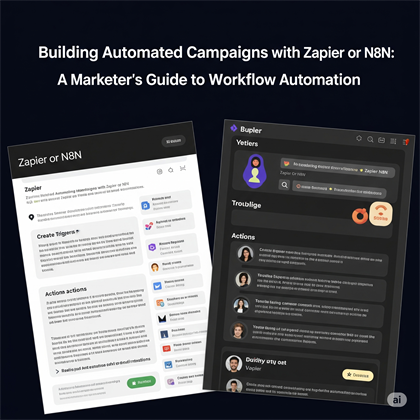
Launching one product is tough. Launching multiple products across multiple verticals? That’s a whole different game.
Whether you're a SaaS platform expanding into new industries or an enterprise offering tailored solutions for different segments, a Multi-Product Go-to-Market (GTM) strategy is critical for sustainable growth — and avoiding chaos.
In this blog, you’ll learn how to structure, scale, and execute a GTM strategy that works across verticals without losing focus or consistency.
What Is a Multi-Product, Multi-Vertical GTM Strategy?
A multi-product GTM strategy involves launching and scaling more than one product — often targeting different buyer personas, industries, or use cases. These can include:
Product variants for different industries (e.g., Healthcare CRM vs. Real Estate CRM)
Add-on modules sold separately
Core platform with industry-specific bundles
The challenge? Crafting tailored messaging, targeted campaigns, and aligned teams — without duplicating efforts or creating silos.
Also Read: Advanced Product Marketing Training
Step-by-Step Framework for a Multi-Product Vertical GTM Strategy
1. Segment Your Verticals & Ideal Customer Profiles (ICPs)
Start with clarity:
Which industries or verticals are you targeting?
What’s the primary ICP in each vertical?
What is the buyer journey and problem context per segment?
Example:
| Vertical | ICP | Pain Point |
|---|---|---|
| Healthcare | Operations Manager | HIPAA compliance, patient coordination |
| Retail | E-commerce Head | Inventory sync, customer loyalty |
| SaaS | RevOps Manager | Tool sprawl, revenue forecasting |
Build a verticalized understanding of your market — this is foundational.
2. Define Core vs. Vertical-Specific Messaging
Avoid reinventing the wheel for each vertical. Instead, break messaging into:
Core Messaging:
Universal value prop, mission, product principles
Vertical-Specific Messaging:
Language, examples, features, ROI relevant to that industry
Core Value Prop Example:
“XYZ helps businesses streamline operations with no-code workflows.”
Vertical Example:
“For healthcare teams, XYZ ensures HIPAA-compliant workflows that reduce admin work by 40%.”
3. Build a Modular GTM Playbook
Instead of creating everything from scratch, build modular GTM assets that can be reused and customized:
| GTM Asset | Core | Verticalized |
|---|---|---|
| One-pager | Universal benefits | Industry use cases |
| Demo deck | Core features | Industry-specific stories |
| Landing page | Brand messaging | Sector-specific keywords |
| Case studies | General results | Industry logos and metrics |
Use frameworks like “Jobs to be Done” to align feature messaging to vertical-specific pain points.
4. Align Product, Marketing, Sales & CS Around Verticals
Multi-product, multi-vertical GTM can break if your internal teams aren’t aligned.
Here’s how to fix that:
Create cross-functional pods per vertical (PM, PMM, Sales, CS)
Develop vertical-specific enablement: talk tracks, battle cards, objection-handling docs
Share market insights across teams (win/loss, competitor moves, feature gaps)
This builds expertise per vertical internally, which improves customer trust and GTM execution.
5. Prioritize & Stagger Launches
Not all launches need to happen at once. Staggering gives you space to:
Focus efforts
Learn fast from early launches
Apply learnings to future rollouts
Prioritize based on:
TAM (Total Addressable Market)
Strategic value
Sales-readiness
Competitive urgency
Example sequence:
Core product launch
Tier 1 vertical (Healthcare)
Tier 2 verticals (Retail, SaaS)
Add-on modules or bundled offerings
6. Create a Verticalized Growth Engine
Your GTM doesn’t stop after launch. Create sustained, scalable growth through:
Vertical SEO content (e.g., “Best Workflow Tools for Healthcare Teams”)
Industry-specific paid ads and LinkedIn targeting
Webinars and roundtables featuring industry leaders
Case study-based nurture emails
Partner marketing with industry solution providers
Think of each vertical as its own mini-market.
7. Measure What Matters per Vertical
Your metrics should be tracked by product and vertical. Focus on:
Adoption and activation by segment
CAC/LTV per vertical
Win rate by industry
Feature usage breakdown
Retention by product bundle
Use this data to decide:
Which verticals to double down on
Where to sunset or simplify offerings
How to refine messaging and UX
Tools & Templates for Execution
Recommended Tools:
CRM with vertical tagging (e.g., HubSpot, Salesforce)
Product analytics (e.g., Mixpanel, Pendo)
Enablement platform (e.g., Highspot)
Marketing automation with segmentation (e.g., Marketo, Customer.io)
Template to Build:
Vertical GTM Playbook (Notion or Google Docs)
Master Messaging Matrix (per product x vertical)
Launch Readiness Checklist
Sales Enablement Toolkit per vertical
Final Thoughts
A multi-product, multi-vertical GTM strategy is complex — but not chaotic when done right. By building repeatable frameworks, aligning teams, and creating tailored value for each segment, you turn a tangle of offerings into a growth machine.
Remember: It’s not just about launching products. It’s about launching value that’s visible, relevant, and irresistible to every industry you serve.
















